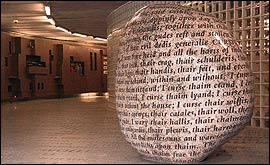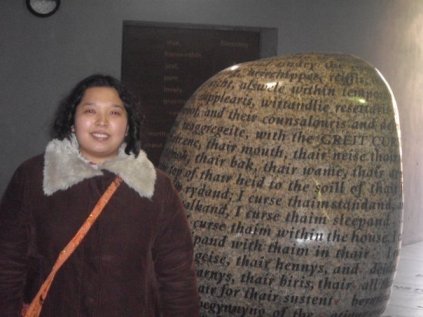Hey, remember when we were all up for welcoming the millennium? Just beneath the atmosphere of forced revelry and jubilation, lurked the fear of the millennium bug and a possible end of the world as we know it, or worse: that we will wake up the next day and nothing has changed other than we all gained a bit of weight from all the partying.
Cities around the world came up with their own little gift to this infinite presence that we call Time, and for its 2000th birthday, we offered it commemorative infrastructure to show we care: hundreds of millennium bridges, millennium halls, millennium parks… I mean seriously, what would this Time fellow have done with it all but who cares let’s put some flowers on it so it looks pretty for the pictures, now go smile and look crazy but happy!
Millennium fever also gripped the UK border city that is Carlisle. Keen to prove they can be as hip as anywhere else, the council had a meeting to come up with ideas about how to welcome the new millennium. Maybe a monument, or a church or a new hospital? How about something to represent our industrial heritage?
No, wait, I know, let’s put a gloomy underpass between the museum and the castle, call it the millennium gallery and decorate it with a 14-ton block of granite inscribed with one of the longest curses in history. I really think that, when the Archbishop of Glasgow, Gavin Dunbar, made the curse to condemn the border reivers (who lived in and around the Carlisle area) in 1525, he thought, “Well, I hope to make enough impact with this statement so that someday, these words will be in a boulder, and bored teenagers can smoke around it as they make their way back to Wigton.”

Any town can produce a scientist or Prime Minister, but achieving “cursed” status demands the dedication of the whole community.
Depending on the historian and the time their book was written,The Border Reivers were either violent villains, infidels and thieves or crafty, unconventional heroes who managed to flout authority, and find their own way of making a living in the Debatable Lands where they reside, located around the border between the perpetual frenemies, England and Scotland. They’re like the helpless children of a marriage where mom and dad don’t get along, and took advantage of the situation by asking the parents for birthday and Christmas presents separately, so the kids get two sets of gifts each time.
The living conditions were harsh in the border region during the heyday of the reivers. The land was not very fertile, the roads were either bad or nonexistent, and near constant wars between England and Scotland lay waste to the fields and ransack towns. Inhabitants often had relatives from both sides of the border, and when hired as mercenaries, they were not above changing sides even in the midst of battle.
It’s hard to care about whatever noble ideas and chivalric notions were being fought for when the “dying part” is delegated to those who would be left destitute, whichever side won. So you just try to not get hurt–things were already going to be bad enough as it was AFTER the war, when you’re left with a stinky field and it’s raining. So it’s not surprising that in the battle of Pinkie Cleugh (1547), it was observed that ” Scottish and English borderers were talking to each other in the midst of battle, and on being spotted put on a show of fighting.”
But border history isn’t all just wars and bloodshed. There were also hangings, treachery, pillaging, abduction and murder. Men reared in war can be dangerous at times of peace. The borderers fought each other, raiding each other’s lands in a never-ending cycle of vengeance and retribution.
Reiving was deemed a profession, so there were rules that separate reiving from plain robbery. The aggrieved party had 3 days to make retribution or reclaim what’s been stolen (usually cattle). And a person who happens upon the avenging party must either join it or be assumed as one of the original raiders. These rules makes you think reiving was so prevalent that there must have been people who were just popping out for tea, and ended up joining the violent Maxwell clan raiding the local Tesco.
It wasn’t a culture built from the bottom-up, but more of a remnant of the ancient border way of life not much different from the Highlanders. Reivers were from all social classes, and though there’s no doubt that these practices helped to preserve a person during such demoralizing times, they also show an unwillingness to participate in the wider community.
In the end, the reivers were eradicated by countless executions instigated by authorities who rob and pillage legally. Perhaps this is what propelled famous Border Reiver Johnnie Armstrong‘s last words, which amounted to claims that whatever his crimes, he was at least honest about it. That statement makes Johnnie almost likeable, until you remember that he should not have committed his crimes AT ALL. It’s like saying, “Yes, he’s a rapist, but at least he’s a humble rapist.”
This is the problem with settling for choosing the “lesser evil.” Doing it opens up the possibility of a world where there is no GOOD, only varying levels of bad. When that happens, you get an archbishop known for physically attacking a cardinal, and sentencing martyr Patrick Hamilton to burn alive at the stake for six hours, to curse YOUR evil way of life.
I’ve no idea if this is the lesson that the artist who made the Carlisle Cursing Stone was trying to give as the new millennium dawned upon the world, but that’s what I’m going to take from it.
References:
http://en.wikipedia.org/wiki/Border_Reivers
http://en.wikipedia.org/wiki/Gavin_Dunbar_(archbishop_of_Glasgow)
http://www.theguardian.com/artanddesign/2005/mar/09/heritage
http://gordonyoung.net/carlise_cursingstone.html
https://suite101.com/a/cursing-stone-a-medieval-curse-a43355
http://www.bbc.co.uk/cumbria/content/articles/2005/03/02/carlisle_cursing_stone_feature.shtml


Pinkie Cleugh–where a Renaissance army defeated a medieval one. Great post on reiving…
Thanks for stopping by. I’m glad you like the post! 🙂